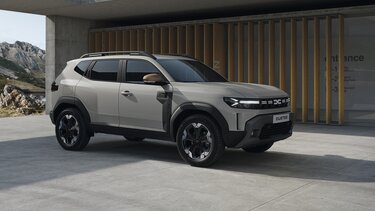What is an SUV?
30/09/2024
WHAT IS AN SUV?
Due to their popularity, SUVs form a significant part of the range offered by most car brands. However, there is a lot of confusion when trying to define this vehicle category. What are the features of an SUV? How does an SUV stand out from other similar vehicles such as 4x4s and crossovers?
MEANING AND ORIGINS OF THE “SUV” ACRONYM
First of all: what does “SUV” stand for? Originating in the USA, this acronym stands for “sport utility vehicle”. Although there is no need to explain the meaning of the word "sport", the following two English words deserve some clarification.
In the USA, a “UV” (utility vehicle), designates a vehicle type that can perform certain tasks more efficiently than a “conventional” passenger car.
Although 4-wheel-drive estate cars marketed in the USA at the beginning of the 1950s are among the predecessors of this type of body, the name "SUV" is considered to have become popular across the Atlantic in the late 1980s.
DEFINITION OF AN SUV
An SUV is a hatchback or two volume vehicle (an engine compartment and a passenger compartment) with a high and voluminous body, hence its resemblance with 4x4s. These features (vehicle size and ground clearance, i.e. the distance between the ground and the bottom of the chassis) make the SUV a versatile car, both family-oriented in terms of number of seats and having off-road qualities. However, these qualities fall short of those specific to 4x4 vehicles. So it would be more accurate to use the term “off-road vehicles” to designate SUVs.
All of these off-road capabilities, interior comfort, towing, etc., give the vehicle its "utility" element, to which its name refers.
Good to know:
- “Compact SUVs” quite simply designate smaller SUVs.
- SUVs are not associated with an approved legal definition. This is probably due to a lack of strict criteria (some have 4-wheel drive, others don't, etc.). Therefore, there is no specific code for SUVs on European vehicle registration cards.
- SUVs come with all engine types: internal combustion (petrol or diesel); hybrid; electric; and bi-fuel.
- Due to their size and weight, SUVs have on average larger tyres than those of other private passenger transportation vehicles (excluding 4x4s).
DIFFERENCES WITH 4X4s
4x4s are primarily designed for off-road driving, sometimes on rugged and steep terrain. Even when equipped with 4-wheel drive (4x4), SUVs do not have the features for driving on the most difficult terrain, such as, differential lock, two axles to drive the front and rear wheels, two gear levers, etc.
SUVs are in fact often called “urban 4x4s” or “city 4x4s”, because they are a compromise between an MPV and an off-road 4x4 vehicle.
DIFFERENCES WITH CROSSOVERS
At first glance, it can be difficult to tell the difference between an SUV and a crossover. These two vehicle types both have a huge body, high ground clearance and fairly large tyres. However, they have very distinct bodies. Crossovers, the rugged version of the saloon, are generally less spacious than SUVs, they are also less adventurous, and more city-oriented than the latter. They also hardly ever have 4-wheel drive, whereas this option is fairly common with SUVs.
SUV, A VEHICLE THAT IS GAINING GROUND
Over time, the SUV has established itself on the automotive market as a sportier alternative to MPVs. Like the Espace 6, the latest version of the historic Renault family MPV, which has become an SUV.
The main reasons for the popularity of SUVs include:
- the depth and the height of the passenger compartment, synonymous with passenger comfort and which is particularly practical for the elderly or for people with reduced mobility;
- the boot space, generally fairly large;
- the vehicle’s versatility, mainly used on the road but can venture on other types of roads (in particular for SUVs with 4-wheel drive).
Good to know:
SUVs are sometimes criticised for being too thirsty for fuel. Although their heavy weight logically leads to higher fuel consumption per kilometre than that of a city car or saloon, it should be noted that these differences are tending to decrease. Indeed, in recent years, most car manufacturers have been working on reducing vehicle weight and improving aerodynamics.
DUSTER, THE SUV ACCORDING TO DACIA
Within the Dacia vehicle range, the SUV category is embodied by Dacia Duster. The emphasis has been on versatility: Duster, of course, is a family car designed for long road trips, but it is particularly at ease with the off-road element of SUVs. The 4-wheel drive version takes the off-road performance of this vehicle to another level.
This SUV comes in Bi-Fuel (Petrol+LPG), Petrol and Hybrid.
Find out more about Duster, the versatile and family-oriented SUV
See More

21/11/2024






